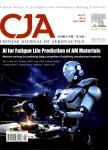Defect suppression mechanism of ultrasonic vibration-assisted drilling carbon fiber/bismaleimide composite
作者机构:Key Laboratory of High Performance Manufacturing for Aero EngineMinistry of Industry and Information TechnologySchool of Mechanical EngineeringNorthwestern Polytechnical UniversityXi’an 710072China Engineering Research Center of Advanced Manufacturing Technology for Aero EngineMinistry of EducationSchool of Mechanical EngineeringNorthwestern Polytechnical UniversityXi’an 710072China School of Mechanical EngineeringSichuan UniversityChengdu 610207China
出 版 物:《Chinese Journal of Aeronautics》 (中国航空学报(英文版))
年 卷 期:2023年第36卷第8期
页 面:366-380页
核心收录:
学科分类:08[工学] 082503[工学-航空宇航制造工程] 0825[工学-航空宇航科学与技术]
基 金:co-supported by the Sichuan Science and Technology Program(Grant No.2020YFG0109) the NSAF of China(Grant No.U1830122)
主 题:CFRP Defect suppression Rod chip Thrust force UVAD
摘 要:Ultrasonic vibration-assisted drilling(UVAD)has recently been successfully applied in the drilling of carbon fiber reinforced polymer/plastic(CFRP)due to its high *** defects have been observed in the CFRP drilling process which negatively affects the quality of the *** carbon fiber/bismaleimide(BMI)composites is an advanced kind of CFRPs with greater strength and heat resistance,having been rapidly applied in lightweight and high temperature resistant structures in the aerospace *** suppress the defect during the drilling of carbon fiber/BMI composites,it is necessary to comprehensively understand the defect formation and suppression mechanism at different *** this study,the defects formation in both conventional drilling(CD)and UVAD were observed and *** variation trend in the defect factor and thrust force with the spindle speed and feed rate were *** results revealed that the UVAD could significantly enhance the hole’s quality with no delamination and ***,the defect suppression mechanism and thrust force in UVAD were analyzed and verified,where the method of rod chip removal affected the exit defect *** summary,UVAD can be considered a promising and competitive technique for drilling carbon fiber/BMI composites.



